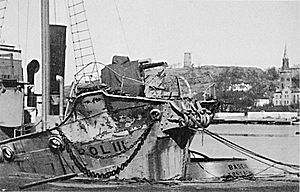Action in the Oslofjord facts for kids
Quick facts for kids Action in the Oslofjord |
|||||||
|---|---|---|---|---|---|---|---|
| Part of the Norwegian Campaign in World War II | |||||||
 The ship Pol III in Tønsberg. The bow is damaged from ramming the German torpedo boat Albatros. |
|||||||
|
|||||||
| Belligerents | |||||||
| Commanders and leaders | |||||||
| Leif Welding-Olsen † | Oskar Kummetz | ||||||
| Strength | |||||||
| 2 forts 1 patrol boat |
2 heavy cruisers 1 light cruiser 2 torpedo boats 8 minesweepers |
||||||
| Casualties and losses | |||||||
| 1 killed 14 captured 1 patrol boat damaged |
1 torpedo boat sunk | ||||||
The Action in the Oslofjord was a short but important naval battle during World War II. It happened late on April 8, 1940, in the Oslofjord in Norway. German ships were trying to reach Oslo to invade the country. They met Norwegian defenses in the fjord. This fight led to the first Norwegian soldier being killed in the war. The Germans managed to get past these first defenses. They then headed towards Drøbak Sound, where they would face much stronger resistance.
Contents
Why the Battle Happened
To invade Norway, Germany split its navy into six groups. One of these groups, called "Kampfgruppe 5," was ordered to sail through the Oslofjord. Their goal was to land soldiers in Oslo.
German Invasion Force
This German group included powerful warships. There were two large ships called heavy cruisers, the Blücher and the Lützow. There was also a smaller light cruiser called Emden. The group also had three fast torpedo boats: Möwe, Kondor, and Albatros. Eight minesweepers also joined them. The German ships had orders not to shoot first unless they were attacked.
Norwegian Defenses
The outer parts of the Oslofjord were protected by the Oslofjord Fortress. This defense system was built in 1914. It included smaller forts at Bolærne and Rauøy. These forts had guns to stop enemy ships.
The Norwegian Navy also had patrol ships. One of these was HNoMS Pol III. It was a small ship armed with a 76 mm gun and two machine guns. It had a crew of 15 sailors. Captain Leif Welding-Olsen was its commander. On the night of April 8, Pol III was patrolling the Oslofjord.
The Action Begins
Just after 11:00 PM on April 8, Lieutenant Hans Bergan on Pol III saw the German ships. They were entering the Oslofjord. The patrol boat fired a warning shot. Then, Pol III moved closer to the German torpedo boat Albatros.
Captain Olsen's Stand
Admiral Oskar Kummetz, the German commander, saw the Norwegian patrol boat. He ordered Albatros to stop it. Captain Leif Welding-Olsen of Pol III spoke briefly with the German commander, Kapitanleutnänt Siegfried Strelow. The German demanded that Olsen surrender, but Olsen refused.
Captain Olsen realized that Norway's neutrality was being broken. He quickly sent a radio warning to Horten Naval Base. He said, "Alien ships incoming at high speed." He also fired special flares for the Norwegian coastal artillery. These flares meant, "Enemy ships are forcing the line." Then, Captain Olsen bravely ordered Pol III to ram the German ship Albatros.
The Fight and First Loss
After being rammed, and seeing the guns on Pol III ready, the German commander ordered his ship's anti-aircraft guns to fire. Captain Olsen was hit by gunfire in his leg. The Norwegian ship caught fire. The order was given to leave the ship. The lifeboat was put into the water but it flipped over. The crew had to hold onto its sides.
Captain Olsen was losing a lot of blood. He became too weak to hold on and sadly drowned. He was the first Norwegian soldier to die in World War II. The other 14 surviving crew members were picked up by the German ships and taken as prisoners.
Forts Fire Warning Shots
At 11:30 PM, the German ships were spotted by the searchlight at Rauøy fort. The fort's southern guns fired two warning shots. Two minutes later, at 11:32 PM, Bolærne fort also fired a single warning shot. At 11:35 PM, Rauøy fort aimed at the German cruiser Blücher. It fired four live shells, but they missed because of thick mist. Soon after, the German ships disappeared into the mist, and the forts lost sight of them.
What Happened Next
The German ships continued sailing down the fjord towards Oslo. The warning from Captain Olsen was sent from Rauøy fort to Oscarsborg Fortress. This warning helped the fortress prepare. At Oscarsborg, the Norwegians were able to stop the Germans in the Battle of Drøbak Sound. They sank the German cruiser Blücher and badly damaged Lützow.
German minesweepers and two torpedo boats left the main group. They landed troops in the area the next morning. The Norwegian soldiers left their forts over the next few days. The German torpedo boat Albatros, which was rammed by Pol III, ran aground and sank on April 10.
After Oscarsborg Fortress surrendered, the rest of the German "Kampfgruppe 5" landed in Oslo on April 10. The Norwegian prisoners were released after they promised not to fight anymore. They were allowed to go home.
HNoMS Pol III was left burning and floating in the fjord all night. It rained, and the fire eventually went out on its own. The next morning, another Norwegian patrol boat, Skudd 2, found Pol III. It was towed to Tønsberg, where the Germans later captured it.
Images for kids



